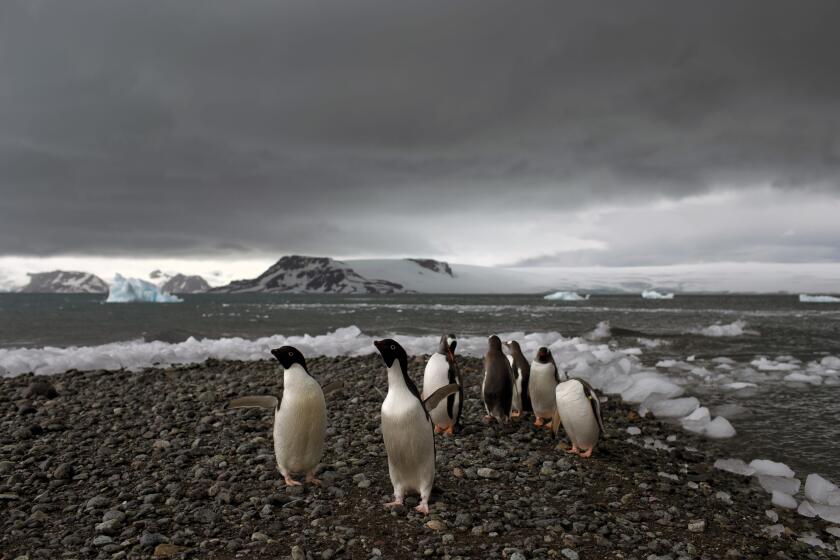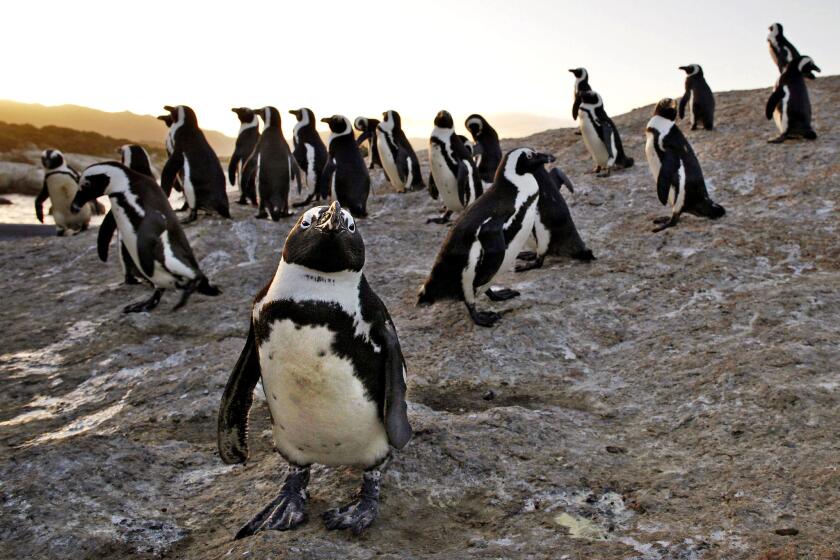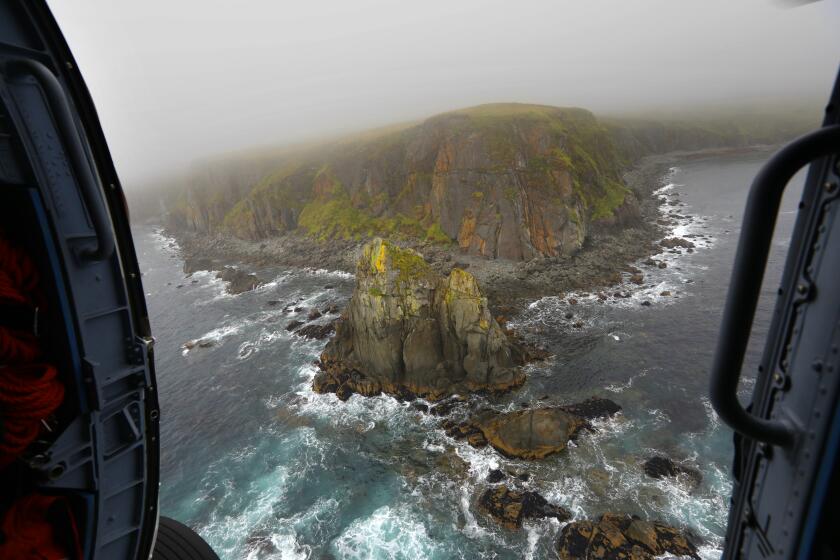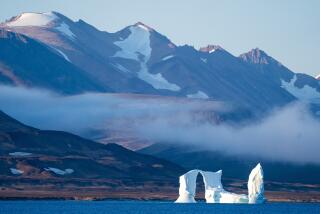Record sea ice melt in Antarctica doomed thousands of penguin chicks to a watery grave
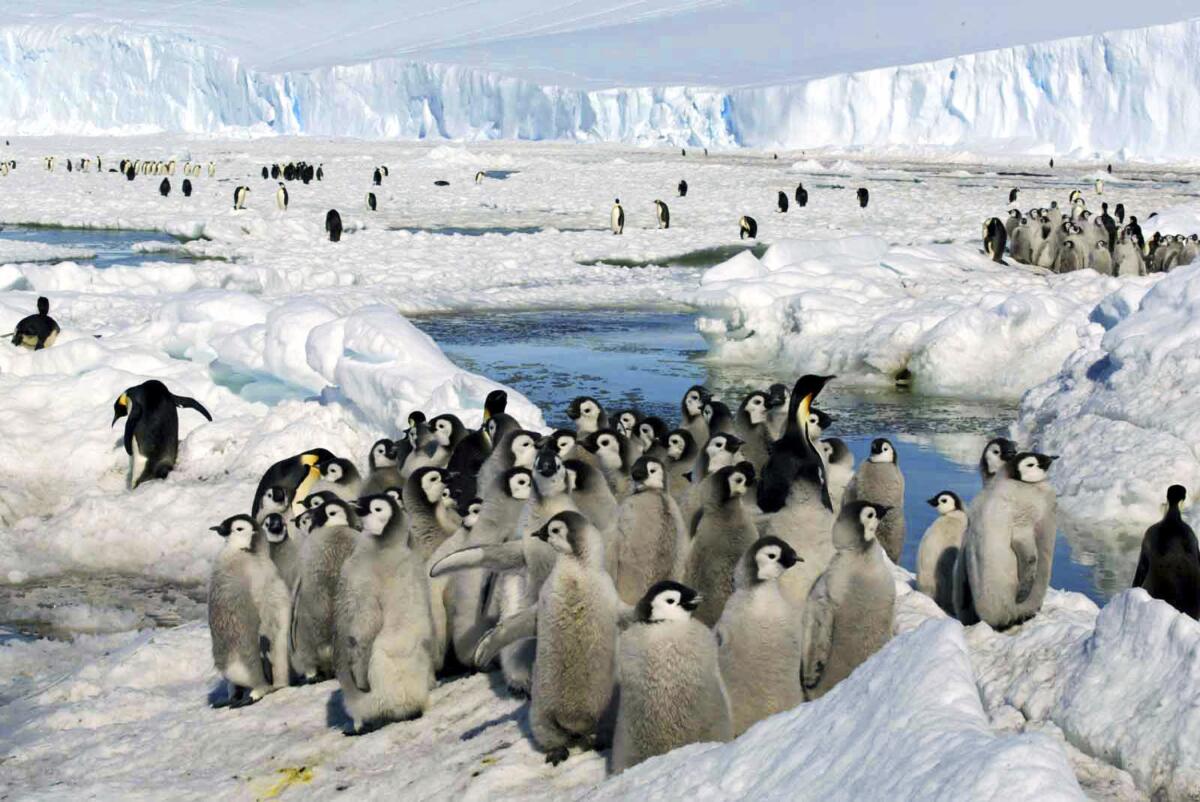
- Share via
Emperor penguin chicks emerge from their eggs in the coldest days of Antarctica’s winter. For the first months of their lives the birds are defenseless gray fluffballs, seeking warmth at their parents’ feet or in protective scrums at the center of their colony.
Unlike their parents, whose sleek black-and-white feathers seal their skin against the frigid ocean, chicks’ downy plumage isn’t waterproof. They must stay atop the ice and away from the sea until their watertight feathers emerge, typically around four months after hatching.
By this time it’s December, and summer is arriving in Antarctica. The ice soon breaks up for the season, and the colony’s newest members can safely follow the adults into the ocean to hunt.
The survival of each new generation of emperor penguins relies on the presence of ice beneath those tiny feet. As many biologists have feared, the unseasonably early disappearance of Antarctica’s winter sea ice last year proved disastrous for the species.
Toward a more sustainable California
Get Boiling Point, our newsletter exploring climate change, energy and the environment, and become part of the conversation — and the solution.
You may occasionally receive promotional content from the Los Angeles Times.
Using satellite imagery, researchers found that four of five observed emperor penguin colonies in the Bellingshausen Sea region of western Antarctica experienced “catastrophic breeding failure,” meaning that no chicks born in 2022 are believed to have survived.
The complete demise of those four colonies is described in a paper published today in the journal Communications Earth & Environment.
After completing that research, lead author Peter Fretwell of the British Antarctic Survey said he examined satellite images of the remainder of the continent’s 66 known emperor penguin colonies.
In 19 of them — nearly 30% — most if not all of the chicks are believed to have drowned or frozen to death when the ice that once supported them melted into the sea, he said.
Although individual colonies will occasionally experience an isolated season of failed breeding, “this is the first time we’ve really seen a whole area be lost because of the sea ice,” said Fretwell, a mapping specialist.
A new study concludes that Antarctica is already being and will continue to be affected by more frequent and severe extreme weather events.
The chicks were casualties of an unprecedented retreat of Antarctic sea ice. On Feb. 21, NASA recorded 691,000 square miles of summertime sea ice, an area 50,000 square miles smaller than the previous record set a year before.
It’s a record that seems likely to fall once again this year. The extent of Antarctica’s winter sea ice is smaller than it has ever been, with an area the size of Greenland simply missing from the coverage scientists expected. With less ice to start with, it’s very possible there will be less in the summer.
“It’s almost certain that this year is going to be worse than even 2022,” Fretwell said. “It’s a rather depressing story for emperor penguins.”
Until fairly recently, emperor penguins enjoyed a secure place in Antarctica’s ecosystem.
The continent is home to an estimated 600,000 individuals. The largest of Antarctica’s penguin species, emperors are distinguished in adulthood by their sleek black dorsal feathers, gold-streaked beaks and a resting posture that gives the impression of a bird looking regally skyward.
Until the advent of satellite imagery powerful enough to spot remote patches of ice with the telltale stains of penguin droppings, most of their colonies were entirely unknown to humans. Nearly half of today’s identified colonies were discovered in the last 15 years by Fretwell, who pioneered the science of penguin census-taking by satellite.
Ensconced on the ice, emperor penguins have largely avoided human efforts to hunt them, overfish their prey or encroach on their territory.
Still, scientists familiar with the species say it’s common for a colony to experience the occasional bad breeding season.
“Colony failures and early breakup of ice isn’t uncommon,” said Michelle LaRue, a marine biologist at New Zealand’s University of Canterbury who wasn’t involved in the research. Normally, it’s “a colony here and there, every once in a while,” she said. “Not like what Peter has just shown.”
Climate change and overfishing off Africa’s southern tip have set a “trap” for endangered African penguins leaving their nests.
For the study, Fretwell looked at satellite images of five known emperor penguin colonies in Antarctica’s Bellingshausen Sea region, which saw a particularly stark decline in sea ice last year.
The five colonies are collectively home to 7,000 to 10,000 breeding pairs of birds in any given year, Fretwell said. Starting in September, about a month after the chicks hatched, his team began examining images of the area taken every few days to few weeks.
By November, when the colonies’ chicks were still in their fluffy vulnerable stage, Fretwell noticed that sea ice that typically held into January was rapidly retreating. Prior data showed that only one of the five colonies had lost its ice during the four previous breeding seasons.
Last year was different. By early December, ice in four of the five colonies had dissipated entirely, forcing adult penguins to abandon the breeding ground early and consigning the chicks to a premature end.
In the Rothschild Island colony, home to the smallest population of the five, a lucky break in the bay’s geometry preserved the sea ice until the offspring of its roughly 700 breeding pairs had fledged.
It is “unprecedented,” Fretwell and his co-authors wrote, to see total breeding failure across an entire region. And the future looks even more bleak.
“Our sea ice models and penguin population projections suggest we’re going to lose over 90% of the colonies and well over 90% of the population by the end of the century,” Fretwell said.
Scientists are seeing changes off Alaska that have never been documented before, as warming upsets a vast ecosystem and one of the world’s vital fisheries.
Few creatures living at the poles are immune to the effects of climate change. But Antarctica’s largest penguin is profoundly vulnerable, biologists said, despite being generally tough birds.
“The Emperors are in big trouble,” said Steve Emslie, an expert in Adelie penguins at University of North Carolina Wilmington who was not involved in this research.
Without some sort of significant adaptation, such as moving to dry land to breed, emperor penguins “will continue to suffer breeding season losses from sea ice melting and breaking out too soon each year and the population will continue to decline,” Emslie said.
LaRue shared his concern.
“Emperor penguins tend to be quite resilient, but I don’t know how long that resilience can hang on given the extreme changes we’ve seen,” she said.
The colonies Fretwell observed aren’t large enough for this failed season to have a lasting impact on the species’ overall population, LaRue said. The bigger fear is that this collapse will turn out to be a bellwether for repeated failures in other colonies.
“They’re a window on the sea ice ecosystem,” Fretwell said of the emperor penguins. The birds’ future is directly tied to a warming sea and diminishing ice, both of which are happening faster than scientists predicted.
But their fate is not yet sealed, he said. If humans are able to reduce greenhouse gas emissions and stop global warming from continuing unabated, “we can change the fate of the emperor penguin and many other species,” he said, “including our own.”
